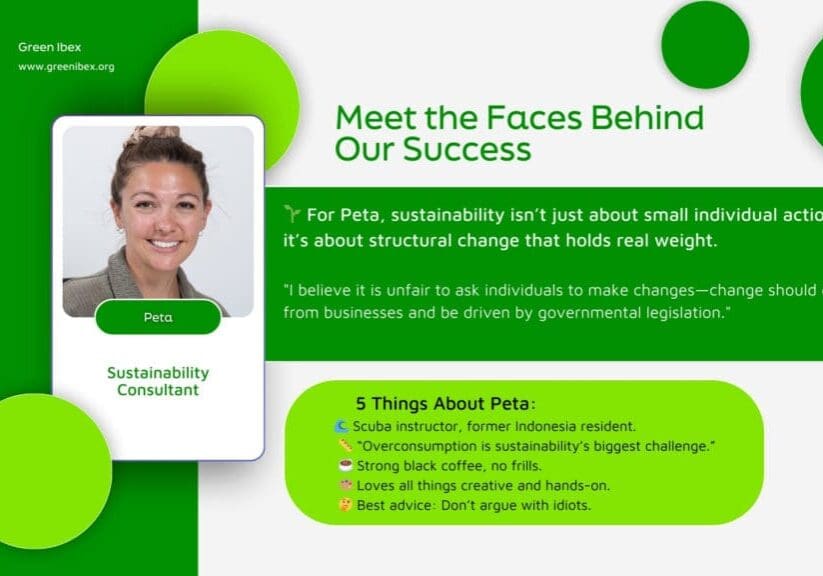Green Ibex
Knowledge Hub
How to achieve net zero emissions for your business
Climate action is not just about ticking boxes – it’s about leading the charge towards a healthier planet while driving innovation and resilience.
Think of the Paris Agreement as a global pact to keep our planet’s temperature in check, aiming to limit warming to 1.5°C above pre-industrial levels. This isn’t just a nice-to-have; it’s crucial for a sustainable future and a resilient business. It this means stepping up to the plate and committing to net zero emissions. Let’s talk about why going net makes a ton of sense for businesses.
In this article, we aim to guide you on how to transition to and maintain net zero status. We’ll delve into practical steps, strategies, and challenges, and show an example roadmap to get you ready to make a meaningful impact.
What does it mean to be a net zero business?
What makes a business net zero? A net zero business can be defined as one that balances the amount of greenhouse gases it emits into the atmosphere with the amount it takes out. This balance can be achieved through various methods. For example, by reducing emissions from operational activity or investing in projects that absorb or offset emissions, such as reforestation or carbon capture technologies.
The corporate net-zero standard set out in the SBTi says businesses must try to cut all possible emissions – usually more than 90% – before turning to offsetting. And they should do it by 2050. The SBTi puts emphasis on setting long-term targets aligned with scientific evidence
It might sound like a demanding regulation, but achieving a net-zero business comes with its benefits. We have dedicated an article on the benefits of the first step towards net zero – having a credible baseline and a plan.
Benefits and responsibilities of a net zero business
Transitioning to a net zero business model can generate many benefits for your business. From optimising processes and creating efficiencies to driving greater brand credibility, these benefits extend well beyond the short term. And the good thing is, you don’t have to achieve everything right now – you should start small, and then scale.
For example, using renewable energy sources can lead to substantial cost savings over time. If you’re in real estate – trial it with one site before committing to it fully. It will enhance your compliance with the latest EPC and ESOS regulations, and therefore help you avoid penalties.
Other benefits are:
- Investor confidence – did you know that some lenders prioritise businesses that can showcase their sustainability goals and carbon reduction plans?
- Saving on insurance premiums – today’s insurers are picking up on climate risks and increasing premiums for businesses that cannot demonstrate a credible risk mitigation plan. Having one and supplementing it with a carbon reduction roadmap means you’re much more likely to get a better insurance deal.
To tap into the funding and support for transitioning to net zero, you need to start now. Waiting until later will mean having to self-fund a bigger portion of it, reducing your overall impact and your savings potential.
Social responsibilities
ESG requirements are tightening with more vigilant regulations and policies. Businesses have a social responsibility to contribute to global sustainability goals. By committing to net zero, your business can be a better corporate citizen and create jobs in a low-carbon economy.
A commitment of this nature has two considerations: reducing your own emissions in the near-term, but also influencing your supply chain(s) and enabling greener choices for customers in the longer term.
Net zero targets and goals
Setting clear near-term and long-term targets is essential for any business aiming to achieve net zero. It goes without saying that these targets should align with the latest climate science to ensure they are ambitious and effective in limiting global warming to 1.5°C.
What are near-term net zero targets?
Near-term targets typically tackle emissions that are within a business’ immediate control, such as Scope 1 and 2 emissions (see below graphic for breakdown). They are vital for making immediate progress. Most companies set to achieve these by 2030 or 2035. These might include energy efficiency measures, switching to renewable energy sources, and reducing waste. Setting, achieving, and monitoring these goals helps build momentum.
What are long-term net zero targets?
Long-term targets usually have a deadline of 2045 or no longer than 2050, it depends on the company. They are necessary for sustaining a vision and the journey to net zero. These might involve more significant changes such as transitioning to a circular business model and investing in advanced carbon removal technologies. Long-term planning enables you to adapt and thrive in a low-carbon economy while continuing to reduce your environmental impact.

How businesses transition to net zero
Top tips for a successful transition
1. Measure
To transition to net zero, you first need to understand your current carbon footprint. This involves a comprehensive assessment and calculation of all GHG emissions produced in your business operations. This includes direct emissions from owned or controlled sources, indirect emissions from the generation of purchased electricity, and all other indirect emissions that occur in your value chain (like staff travel and waste disposal).
Tools and frameworks such as the Greenhouse Gas Protocol can be used to standardise this assessment. By identifying the sources and intensity of your emissions, you can prioritise areas for improvement and track progress over time.
2. Set targets
Once you have a clear understanding of your carbon footprint, the next step is to set realistic and measurable targets. These targets should be credible and aligned with science-based benchmarks – and it helps if you validate them with SBTi or equivalent. You can follow the Net Zero Corporate Standard , to ensure your targets contribute meaningfully to global climate goals.
3. Deliver
To successfully deliver on your net zero goals, secure top-level commitment and buy-in across your organisation. Allocate sufficient budget and resources, and assess your internal capabilities to identify where external expertise may be needed. Break down your transition into smaller, manageable projects and involve staff from various departments to foster collaboration and accountability.
Auditing your internal processes and capabilities is crucial at this stage. This involves evaluating existing systems and procedures to identify gaps and areas needing improvement. Consider commissioning external expertise for specialised tasks or providing additional support where necessary.
4. Monitor
Monitoring your progress is essential to track your journey towards net zero. Establish robust monitoring and reporting mechanisms to regularly assess and review your emissions reduction efforts. This ensures accountability and transparency, helping you stay on track to meet your targets.
Implementing advanced software solutions and data analytics can streamline this monitoring process, providing real-time insights into your emissions performance. Regularly communicate progress updates internally and externally to stakeholders to maintain momentum and demonstrate your commitment to sustainability.
Effective carbon offsetting techniques
What are carbon offsets?
They are credits purchased by a company to compensate for their GHG emissions. Each credit typically represents one tonne of carbon dioxide equivalent (CO2e) reduced or removed from the atmosphere through various projects.
To ensure the effectiveness and credibility of carbon offsets, you should invest in high-quality offsetting projects that are verified by reputable certifications such as the Verified Carbon Standard (VCS) , the Gold Standard , or the Climate Action Reserve .
Reliable projects include reforestation, renewable energy installations, and methane capture from landfills.
Renewable energy sourcing
Another common tactic businesses use is switching to renewable energy sourcing. It offers multiple benefits, including reducing GHG emissions, lowering energy costs in the long run, and enhancing energy security. Renewable energy sources are also less vulnerable to price fluctuations compared to fossil fuels, providing businesses with more stable and predictable energy costs.
The top 3 most commonly used renewable energy sources are:
- Solar power
- Wind power
- Hydro power
Energy efficiency measures
We can’t talk about net zero without talking about energy efficiency. It’s a critical component of reducing a business’s carbon footprint. This can involve upgrading to energy-efficient lighting, heating, and cooling systems, and using advanced building materials that reduce energy consumption. Another tactic companies use is investing in energy-efficient machinery and equipment for production processes.
Let’s not forget the importance of regular energy audits. Conducting regular audits is essential to identify areas where energy use can be optimised. In this way, businesses assess how energy is used within a company and pinpoint opportunities for improvements. This can result in substantial cost savings and reduced emissions. One last thing – energy audits should be an ongoing process.
The main challenges
High initial costs
Most businesses don’t want to hear this, but transitioning to net zero often requires significant upfront investments in sustainable technologies and infrastructure, such as renewable energy systems, energy-efficient equipment, and advanced waste reduction processes.
Although the initial costs are high, these investments usually lead to long-term savings and operational efficiencies. Adopting a phased approach can help manage costs by prioritising quick-return investments and gradually scaling up sustainability initiatives.
Fortunately, various financial aids and incentives are available from governments and organisations worldwide, including tax credits, grants, low-interest loans, and subsidies for renewable energy projects, energy-efficient upgrades, and green technology R&D. Leveraging these opportunities can help offset initial costs and accelerate your sustainability journey.
Regulatory uncertainty
There’s no one-size-fits-all answer here. Emissions and sustainability regulations can vary a lot between countries and even regions within countries. This can be confusing, especially if your business operates in multiple areas. To manage this, keep up with the latest regulations and connect with policymakers. Or, you can reach out to us, and we’ll handle it for you.
Another crucial aspect is measuring and reporting your emissions accurately. This is key to tracking your progress and showing your commitment to net-zero goals. Use tools like the Greenhouse Gas Protocol to get a comprehensive view of your emissions. Advanced software and data analytics can make this process even more accurate and efficient.
Adopting best practices that go beyond just meeting regulatory requirements can also help. This approach keeps your business compliant and flexible as regulations change.
Finally, regular reporting, both internally and externally, ensures accountability and transparency. This helps you build trust with stakeholders and continually improve your sustainability efforts.
Navigating cultural shifts for sustainable practices
Switching to sustainable practices, like using eco-friendly materials in product design, can shake things up if not handled right. It’s crucial to weave sustainability into your policies and processes. This means setting clear sustainability goals (KPIs) for your teams and holding everyone accountable.
To manage this transition smoothly, view sustainability as a core part of your business, not a separate initiative. Use tools like process mapping and change management frameworks to guide the process.
Be sure to communicate the importance and long-term benefits of sustainability to all stakeholders to gain their support and commitment to net-zero goals.
Getting good quality data from the supply chain
You might already know this, but achieving net zero emissions requires addressing the entire value chain, including suppliers. Businesses must collaborate with their suppliers to ensure they adopt sustainable practices and meet net-zero standards. This can involve setting clear sustainability criteria for supplier selection. Providing support and resources for suppliers will help them reduce their emissions and integrate sustainability into procurement processes.
Ways to monitor and maintain your net zero strategy
Setting and achieving targets
To ensure the success of your net zero strategy, as a business you must regularly review and adjust your targets. This involves setting interim milestones and periodically assessing progress against these goals. Regular reviews will allow your company to identify any shortfalls or areas where adjustments are needed. This is how you stay on track to meet your long-term net-zero objectives.
Remember, flexibility is key. It allows your business to adapt to new technologies, regulatory changes, and other external factors that may impact your sustainability efforts.
Tracking carbon footprints
We did mention this earlier, but continuous monitoring of carbon footprints is essential for maintaining a net zero strategy. By consistently measuring your emissions across all aspects of operations, your business can gain a clear and accurate picture of its environmental impact. This ongoing process helps you identify trends, track improvements, and pinpoint areas that require further action.
Importance of regular maintenance and upgrades
Regular maintenance and upgrades should not escape your to-do list. This includes routine checks and servicing of renewable energy systems, energy-efficient equipment, and other infrastructure.
Make sure you keep up with technological advancements and integrate new solutions. This can further drive down your emissions and improve overall sustainability performance.
How to uphold green practices and maintain credentials in a net zero context
Implementing green logistics: Sustainable transportation and distribution methods
What does green logistics involve? Put simply, adopting transportation and distribution methods that minimise environmental impact.
How can you achieve this? Here are a few options:
- By transitioning to electric or hybrid vehicle fleets
- By optimising delivery routes to reduce fuel consumption
- By utilising rail or maritime transport where feasible
Additionally, partnering with logistics providers that prioritise sustainability can further enhance green logistics efforts. The best part – these practices not only reduces emissions but also often result in cost savings and operational efficiencies.
Sustainable packing and procurement: Using eco-friendly materials and suppliers
Sustainable packaging and procurement are key components of a net zero strategy, but we understand it’s easier said than done. Transitioning to eco-friendly materials like biodegradable, recyclable, or reusable packaging can be challenging and often requires a collaborative effort across departments. Designers play a crucial role here by innovating in their choice of materials and finding ways to recycle and reuse waste.
Sourcing from suppliers who adhere to sustainable practices is also essential. This ensures that the entire supply chain supports net zero objectives. While this can be complex, setting clear sustainability criteria for supplier selection and providing support to suppliers can make a significant difference.
We know these changes can cause disruptions and require significant investment, as we discussed earlier. However, integrating sustainability into your policies and processes, and ensuring top-level departmental buy-in, can make the transition smoother. This might sound daunting and overwhelming, but we’re here to help you navigate these challenges and make your sustainability goals a reality.
All these are great, but so what? We know when it comes to sustainability, it’s easier said than done. At the end of the day, it all boils down to people, communication, and organisational priorities. So let us help make sustainability a strategic priority for you and help you get the appropriate budget.
Share this article
Whitepaper & Guide library
Don't let confusion where to start or lack of internal knowledge stop you. Your Scope 1 and 2 emissions are your customer's Scope 3 emissions – those are the ones they need to report on and will likely request. Check out our guides on getting started with your initial assessment – and give us a shout if you get stuck.





Download the latest Whitepapers and Guides from Normative & Green Ibex
To request a download, please get in touch.
Get in touch
Let’s prepare for the future together
We can tailor services to meet your particular needs. Complete the form or email us and and we can discuss your specific requirements.
Registered Address
71-75 Shelton Street,
London,
WC2H 9JQ,
United Kingdom






